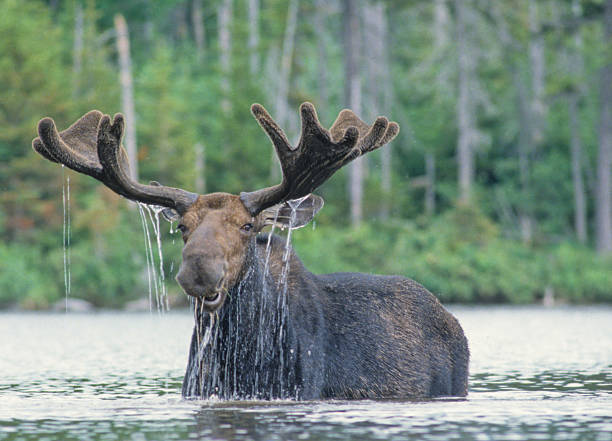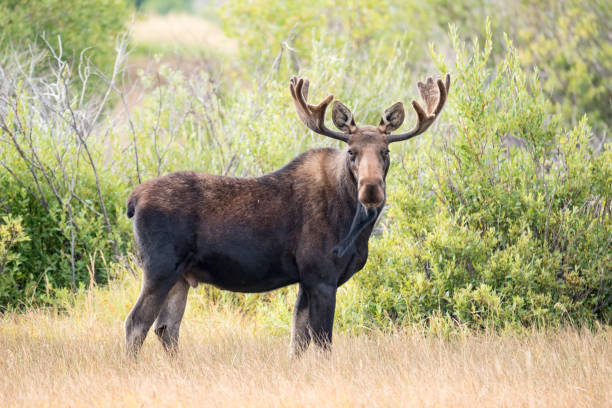Moose communicate with one another and signal to potential predators or threats to their young using a variety of sounds. The duration and pitch of these sounds are variable. Additionally, the sounds that bulls, cows, and calf moose make differ from one another. But what noise does a moose typically make, and why do they do it?
Moose typically make a moaning sound. Moose make this sound for a variety of reasons, but primarily during the rut, or breeding season, to communicate with other Moose.
Why Do Moose Make Sounds?
Moose use their vocalizations to communicate with one another and with predators. Because they are solitary creatures who rarely interact with other moose, moose primarily communicate through sounds.
They are unable to communicate effectively through body language, unlike other species of deer that may live and travel in herds.
Each of the distinctive moose sounds serves a particular function.
Common Sound
It’s possible to say that cow and bull moose make the same kind of sound.
EER UGH would be the spelling of that sound.
Cow moose would emphasize the beginning of that sound, so like EER UGH. Bull moose would not.
On the other hand, a bull moose would shorten the start of that sound and emphasize the UGH.
Bull Moose Sound
Bellow
Until six miles away, a bull moose’s bellow can be heard. During the rutting season, this sound echoes throughout forests where moose live.
The bellow is a call made by a bull moose searching for a cow moose to mate with; it may be in response to a cow moose wail or as a request for a cow moose to respond.
Roar
During the rutting season, moose bulls roar to intimidate other, smaller bulls.
It is common for moose to be quite agitated and on the verge of fighting when they make this sound.
The roar is best described as a deep, roaring sound, sometimes even resembling a lion or a frenzied cow.
Hearing this in the woods can be quite frightening.
Since this call is more of a moose deterrent, hunters don’t imitate it. Its volume and ferocity would make it very difficult to imitate.
A moose may also roar in response to other threats they perceive, such as people, bears, mountain lions, etc.
Croak Or Grunt
The croak is a low-frequency call. It sounds as though someone is gulping or grunting.
Additionally, the bulls only make this noise during the rutting season.
The croak primarily consists of the moose noise’s UGH portion, with a very brief EER at the beginning.
Bull moose use their grunt to try to attract cows so they can breed with them.
To attract the attention of another bull moose looking to challenge a rival, most hunters imitate this sound. The grunt is the most simple to mimic of all the moose calls, and when done correctly, it is very powerful.
Angry Sounds
A bull moose will grunt at intervals when it detects a scent he is unsure of. This sounds somewhat like a hiccup or occasionally like a cough.
They emit this sound when they are alert to a scent they have just picked up, which may indicate the presence of humans, predators, or rival males.
It can last for several minutes and is repeated every two to three seconds. In addition to making this noise, they are frequently observed licking their lips and stamping the ground.

Female Moose Sound
Bark
The sound of a moose barking indicates danger. This sound is not all that dissimilar from a large dog barking and sounds like a deer.
The bark serves as a warning to the young, advising them to act quickly if there is any danger.
Wail Or Moan
When a cow moose is ready to breed and her estrus levels are high, she will wail or moan.
Any nearby bulls are called in with the help of this call.
This call is frequently used by hunters to try to capture large bulls.
The wail or moan sounds like an EER UGH, with a long EER and an abrupt low guttural UGH.
The moan resembles a brief wail. It is not quite as high-pitched and is at a slightly lower volume.
This wail can sometimes last up to six or seven seconds, making it a lengthy call.
Conclusion
Numerous sounds that moose make are well-known. Only the most typical sounds are those we’ve already mentioned.
Additionally, the sounds are not always made by one sex; moose cows have also been observed roaring.
When trying to call moose while in the woods, please proceed with the utmost caution because they are aggressive animals and can easily hurt a person.
FAQ
Why Do Moose Moan?
During the rutting season, female moose scream to attract the attention of moose males who are interested in mating.
Do Moose Snort?
Similar to deer, moose also snort. This snort serves as a warning to predators or anything else that might catch them off guard. This serves as a warning for any small-scale threat.
How Far Can a Moose Hear a Call?
Moose calls can be heard by other moose up to 6 miles away.

